Quad-channel RAM vs. dual-channel RAM: The shocking truth about their performance

 Image: Corsair
Image: CorsairOne of the check-off features of Intel’s big Haswell-E CPU is support for quad-channel DDR4 memory, but my testing shows it may not matter much.
Think of memory channels as shotgun barrels. You know from video games that two barrels are better than one. Now think of quad-channel RAM is the four-barrel shotgun of computers: The more memory channels, the more memory bandwidth available to the CPU.
For each channel in a modern PC, you need an individual stick of RAM. This also depends, of course, on the CPU. Consumer chips such as the Core i7-4790K and the new Core i7-6700K support up to two channels, while consumer chips such as the Core i7-5960X can support up to four channels
Normally this doesn’t matter. You wouldn’t buy an expensive X99 motherboard and pricey Core i7-5960X, then intentionally gimp its quad-channel memory performance by installing only two pieces of RAM instead of four.
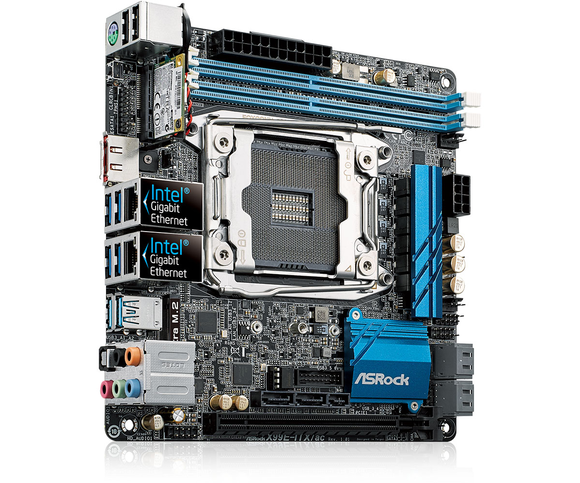 Asrock
AsrockAsrock’s X99 MiniITX board simply does away with two memory channels to save space.
Meet Asrock’s X99E-ITX/ac
The problem? You can’t actually fit Intel’s Haswell-E chip and the four memory slots it needs into a smaller Mini-ITX motherboard. They just don’t physically fit using full-sized memory modules. Without access to Intel’s Haswell-E CPU, that means miniature PCs are limited to quad-core CPUs at best.
Asrock’s crazy solution was simply to leave off two of the slots on its X99E-ITX/ac motherboard. Yes, that cuts your bandwidth in half, but it lets you build such crazy machines as this Falcon Northwest or this exotic CyberPower Trinity Xtreme and run more than four CPU cores. The big question is: How much of a hit do you take?
How we tested
I decided to test just how much real performance you give up by leaving half your system bandwidth behind, As the Asrock X99E-ITX/ac is permanently restricted to dual-channel memory, the only way I could test this was to use a full-size X99 motherboard.
For that I turned to a MicroExpress B20 system we reviewed. It has a full-size Asus X99 Pro motherboard and a six-core Core i7-5820K CPU, along with a GeForce GTX 970 card and 16GB of DDR4/2666 RAM in quad-channel mode, using four 4GB modules. I ran several benchmarks with it in quad-channel mode, then swapped out the four sticks of RAM for two sticks of 8GB DDR4/2666 in dual-channel mode.
I could have just pulled two of the systems’ original four memory sticks but I decided some would be concerned the 16GB vs. 8GB of total RAM would affect the results. It wouldn’t, but I’ll humor you. So for the record: We’re testing 16GB of DDR4/2666 in dual-channel mode vs. 16GB of DDR4/2666 in quad-channel mode.
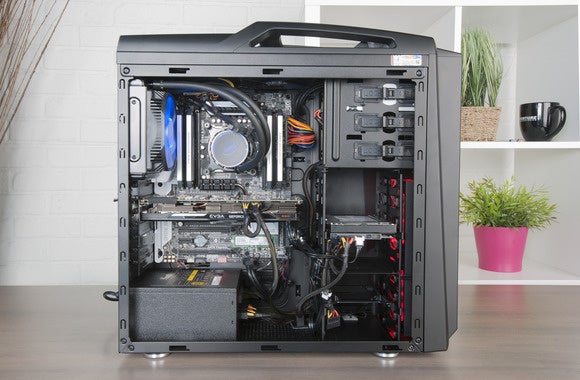
I simluated dual-channel performance using this MicroExpress B20 system with its X99 chipset and Core i7-5820K chip.
Sisoft Sandra Memory Bandwidth
My first test was SiSoft Sandra’s memory bandwidth test. This jack-of-all trades benchmark suite measures and pokes just about everything in your PC. It’s long been a standard to measure available memory bandwidth in a PC. The results were as expected (and also a good way to double-check that I hadn’t put the modules in the wrong slots). Going from dual-channel DDR4/2666 to quad-channel DDR4/2666 nearly doubles the available memory bandwidth. Woohoo! Go home, right?
Nope. This chart is probably the only good news for quad-channel memory, but I’ll let you bask in the bandwidth for now. Read on for the real performance impact.
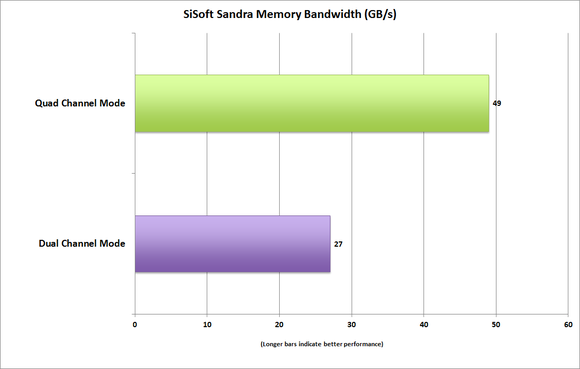
Sorry, dual-channel RAM: Quad-channel is way better.
Encoding performance
Synthetic tests measuring the theoretical performance is one thing, but just where does it show up in real tasks? To find out, the next test I threw at the system was Handbrake. A popular and free video encoder, it’s a CPU-heavy test. As video encoding is something that’s believed to be bandwidth-sensitive, I thought doubling the memory bandwidth would pay off big-time. Unfortunately, if you look at the chart below, I saw zippo. I was quite surprised, as I’ve long believed memory bandwidth helps encoding performance. I’ve actually seen it in the past on older hardware platforms, too, so this was a shocker. I will say: This isn’t the last word, as different encoders and different encoding loads could favor the increased bandwidth. But today, I’m pretty disappointed.
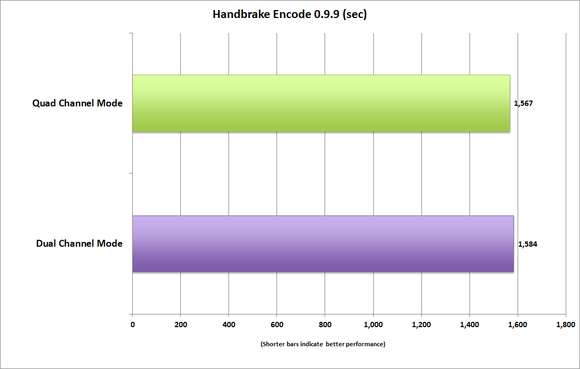
I saw virtually no difference in our encoding test between dual-channel and quad-channel RAM.
PCMark 8 Creative
My next task was PCMark 8’s Creative Conventional test. This synthetic test attempts to simulate a workload of photo editing, video encoding, light gaming and browsing. I run the conventional portion rather than the GPU portion to keep the workload restricted to the CPU itself. The result was, again, pretty surprising and disappointing.
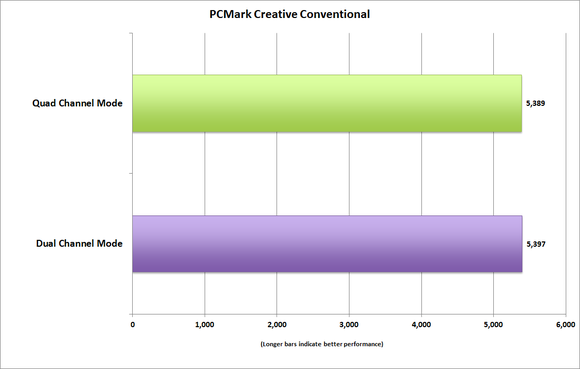
PCMark 8’s Creative Conventional test shows minimal impact too.
PCMark 8 Home
I also ran PCMark 8’s Home and Work Conventional tasks to change up the workload. Again, nearly double the system memory bandwidth made no difference. I’m not even going to bother wasting Internet bandwidth with the chart of PCMark 8 Work’s result, because it’s the same.
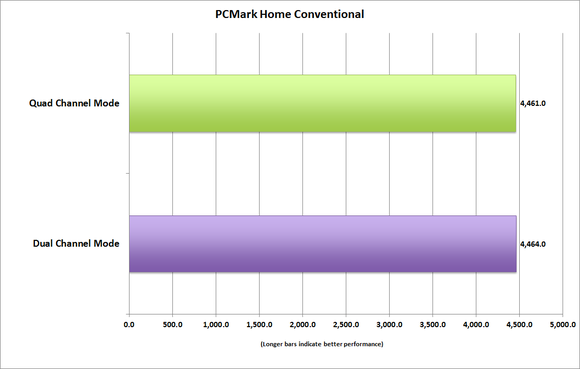
PCMark 8 Home Conventional test also shows a tie between dual-channel and quad-channel memory.
WinRAR
Like video encoding, file compression is one of the tasks that typically benefits from boatloads of memory bandwidth. To find out, I reached for WinRAR 5.21 and used its built-in compression benchmark. Finally I saw the increased memory bandwidth paying off—but not by much.

Despite file compression normally benefitting from memory bandwith, the difference in WinRAR is pretty tiny.
7Zip
I also fired up the beta version of 7Zip and ran its internal benchmark. I actually saw a decent boost from 7Zip, but again, I really expected more. I was almost ready to hang it up but decided to run some gaming tests, too, so keep reading.

We do see an improvement from 7Zip’s internal benchamrk but not as much as I’d expected.
Tomb Raider
For the final set of tests, I fired up a few games that aren’t on the cutting-edge of graphics. The idea is to use older games that would not be bottlenecked by the GeForce GTX 970 in my testbed. It’s a good card and a hell of a deal, but it’s no Titan X. To remove any graphics bottleneck, I also ran the games at a fairly low resolution of 1920×1080, and picked lower image quality settings.
The result? Yup. You guessed it: No diff. Not at ultimate or high. Just squint your eyes and pretend the results are for both.

Running Tomb Raider with the system set to either quad-channel seems to make no difference either.
BioShock Infinite
And yes, BioShock Infinite didn’t care either, even when pushing 200 fps. Like Tomb Raider, I actually ran the test at high and medium settings but decided not to waste bandwidth since it didn’t matter.
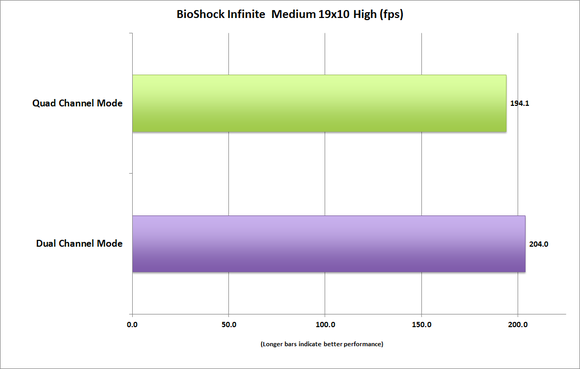
BioShock Infinite at medium settings also shows very little performance improvement.
Dirt Showdown
And yes, more of the same in Dirt Showdown. There’s no reason to show you the three other settings I ran, because they’re all just the same. Read on for my conclusion.
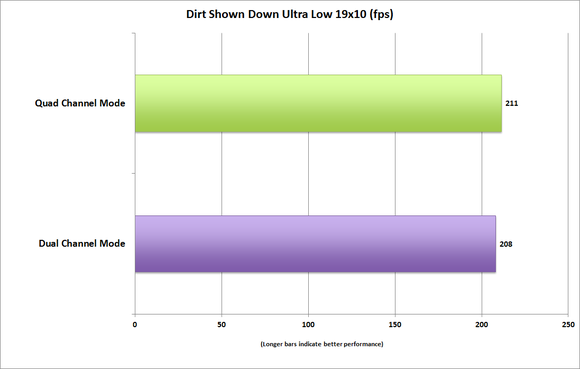
Dirt Showdown also shows it’s a yawner
Conclusion
I’ve written about Asrock’s interesting decision to sacrifice memory bandwidth for core count a few times now. The reaction is usually to recoil from those who just don’t want to make that compromise in memory bandwidth. Give up half your memory bandwidth just to make a smaller system with six or eight cores? Never!
I had the same reaction myself originally. After running my tests though, I’m not sure it matters. I’m sure that somewhere out there beneath the pale moonlight, there’s a task or benchmark that truly pays the dividends you’d expect by doubling the available system bandwidth, but I’m not seeing it here.
Why? I suspect one reason might be the massive 15MB cache in the 6-core Core i7-5820K processor I used. The quad-core Core i7-4790K has an 8MB cache. That’s almost double the cache with only two more cores added to the equation. Could going to an 8-core Core i7-5960X show the weaknesses of cutting system memory bandwidth in half? After my tests today, I’m not so sure it will.
I will say, if I built or bought a full-size X99 Haswell-E machine, I’d still want quad-channel memory, because there’s just no reason to give it up. But if I had to choose a small box where I got six cores instead of four, and my workloads benefited from the extra CPU cores? I’d have absolutely no problem making that decision to throw memory bandwidth overboard.
 Asrock
AsrockSacrificing memory bandwidth for core count doesn’t appear to hurt.






